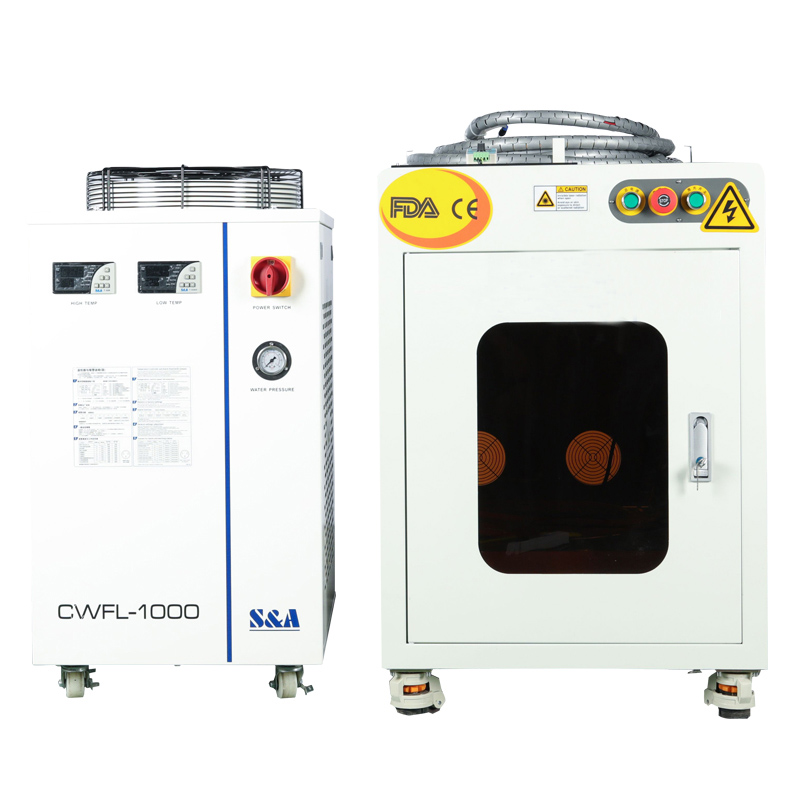Laser welding machine
A laser welding machine is a specialized equipment that utilizes laser technology to join materials together through the process of welding. Here are the key functions of a laser welding machine:
1.Laser Welding: The primary function of a laser welding machine is to join materials together using a laser beam. The laser beam generates high heat, which melts the material surfaces being welded. As the melted material cools and solidifies, a strong bond is formed, creating a welded joint. Laser welding is commonly used for precision welding of metals and can produce high-quality, narrow, and deep welds.
2.Spot Welding: Laser welding machines can perform spot welding by focusing the laser beam into a small spot on the material surfaces. This enables the welding of small, intricate components or parts with minimal heat input and distortion. Spot welding is often used for applications where localized welds are required, such as in the electronics or automotive industries.
3.Seam Welding: Laser welding machines can also perform seam welding, where the laser beam is moved along the joint to form a continuous weld seam. Seam welding is commonly used for joining long components or creating leak-tight seals, such as in the manufacturing of tubes, pipes, or sheet metal assemblies. The ability to precisely control the laser beam allows for accurate control of the weld width and depth.
4.Welding of Dissimilar Materials: Laser welding machines are capable of joining dissimilar materials, such as metals with different melting points or thermal properties. By adjusting the laser parameters and using suitable filler materials, laser welding can effectively join dissimilar materials, expanding its applications in industries such as automotive, aerospace, and electronics.
5.Infrared Welding: Some laser welding machines have the capability to perform infrared welding. Infrared welding utilizes an infrared laser beam to heat the surface of thermoplastics to a molten state, which is then pressed together to form a strong bond. This method is commonly used for joining thermoplastic components in various industries, including automotive, medical, and consumer electronics.
6.Remote Welding: Laser welding machines can be equipped with fiber optic delivery systems or robots for remote welding applications. This allows the laser beam to be delivered to the welding area through fiber optic cables or by robotic arms, enabling welding of components in hard-to-reach or hazardous environments.
7.Automation and Integration: Laser welding machines can be integrated into automated manufacturing processes. They can be synchronized with robotics, conveyors, or other automation systems to enable high-speed and precise welding operations. Integration with automation helps improve productivity, consistency, and repeatability of the welding process.
8.Real-time Monitoring and Quality Control: Laser welding machines often feature real-time monitoring systems that allow for quality control during the welding process. These systems can monitor parameters such as laser power, welding speed, temperature, and displacement, ensuring that the welding is performed within specified tolerances and quality standards.
9.Software Control and Programming: Laser welding machines are typically controlled by software that allows for precise control and programming of the welding process. The software enables the operator to set welding parameters, define weld patterns, and adjust welding speed and intensity. It also offers features for data logging, process optimization, and parameter management.
10.Safety Features: Laser welding machines are equipped with safety features to protect the operator and the surrounding environment. These features may include enclosure interlocks, shielding to contain the laser beam, safety sensors, and emergency stop buttons.

It's important to note that the specific capabilities and features of a laser welding machine may vary depending on the machine's type, power, wavelength, and additional options. Always refer to the manufacturer's documentation and guidelines for the specific functions and parameters of your laser welding machine.
